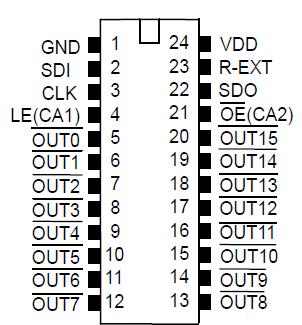Features: · 16 constant-current output channels
· Output current adjustable through an external resistor
· Output current gain programmable for White Balance
· Constant output current range: 5-90 mA
· Excellent output current accuracy:
between channels: ±3% (max.), and
between ICs: ±6% (max.)
· Constant output current invariant to load voltage change
· Fast response of output current, OE(min.): 200 ns
· 25MHz clock frequency
· Schmitt trigger input
· 5V supply voltage Pinout Specifications
Specifications
| Characteristic |
Symbol |
Rating |
Unit |
| Supply Voltage |
VDD |
0~7.0 |
V |
| Input Voltage |
VIN |
-0.4~VDD + 0.4 |
V |
| Output Current |
IOUT |
+90 |
mA |
| Output Voltage |
VDS |
-0.5~+20.0 |
V |
| Clock Frequency |
FCLK |
25 |
MHz |
| GND Terminal Current |
IGND |
1440 |
mA |
Power Dissipation
(On PCB, Ta=25°C) |
CNS type |
PD |
1.52 |
W |
| CF type |
1.30 |
| CP type |
1.11 |
Thermal Resistance
(On PCB, Ta=25°C) |
CNS type |
Rth(j-a) |
82 |
°C/W |
| CF type |
96 |
| CP type |
112 |
| Operating Temperature |
Topr |
-40~+85 |
°C |
| Storage Temperature |
Tstg |
-55~+150 |
°C |
DescriptionMBI5028 succeeds MBI5026 and is designed for LED displays with Gain Control extension.
MBI5028 exploits PrecisionDrive™ technology to enhance its output characteristics. MBI5028 contains a serial buffer and data latches, which convert serial input data into parallel output format. At MBI5028 output stage, sixteen regulated current ports are designed to provide constant current sinks for driving LEDs within a wide range of Vf variations.
MBI5028 provides users with great flexibility and device performance while using MBI5028 in their LED panel system design. Users may adjust the output current from 5 mA to 90 mA through an external resistor Rext, which gives users flexibility in controlling the light intensity of LEDs. MBI5028 guarantees to endure maximum 17V at the output port. The high clock frequency, 25 MHz, also satisfies the system requirements of high volume data transmission.
MBI5028 also exploits Share-I-O™ technology and is backward compatible with MBI5026 in both electrical characteristics and package aspect. To utilize the Current Adjust feature with Share-I-O™ technology, users may not need to change the printed circuit board originally for MBI5026. To enter a special function mode- Current Adjust mode, users just need to set a sequence of signals on LE(CA1), OE(CA2) and CLK input pins. Normally, the output current can be regulated only through an external resistor. In addition, in the Current Adjust mode, the output current can be software-programmable by a system controller. The system controller adjusts the output current by sending a 7-bit Current Adjust code to 16-bit Configuration Latch through MBI5028 SDI pin. The code will be latched and effective to control the output current regulator. A fine adjustment of the output current could be achieved by a gain ranging from 0.5 to 2 with 128 fine steps. By setting another sequence of signals on LE(CA1), O OE(CA2) and CLK input pins, MBI5028 may resume to a Normal mode and perform as MBI5026. The Shift Register, with SDI, SDO, and CLK, carries the image data as usual.
A Share-I-O™ technique is specifically applied to MBI5028. By means of the Share-I-O™ technique, an additionally effective function, Current Gain, can be added to LED drivers, however, without any extra pins. Thus, MBI5028 could be a drop-in replacement of MBI5026.
The printed circuit board originally designed for MBI5026 may be also applicable for MBI5028.
For MBI5028, the pin 4, LE(CA1), and the pin 21, OE (CA2), can be acted as different functions as follows:

 MBI5028 Data Sheet
MBI5028 Data Sheet







